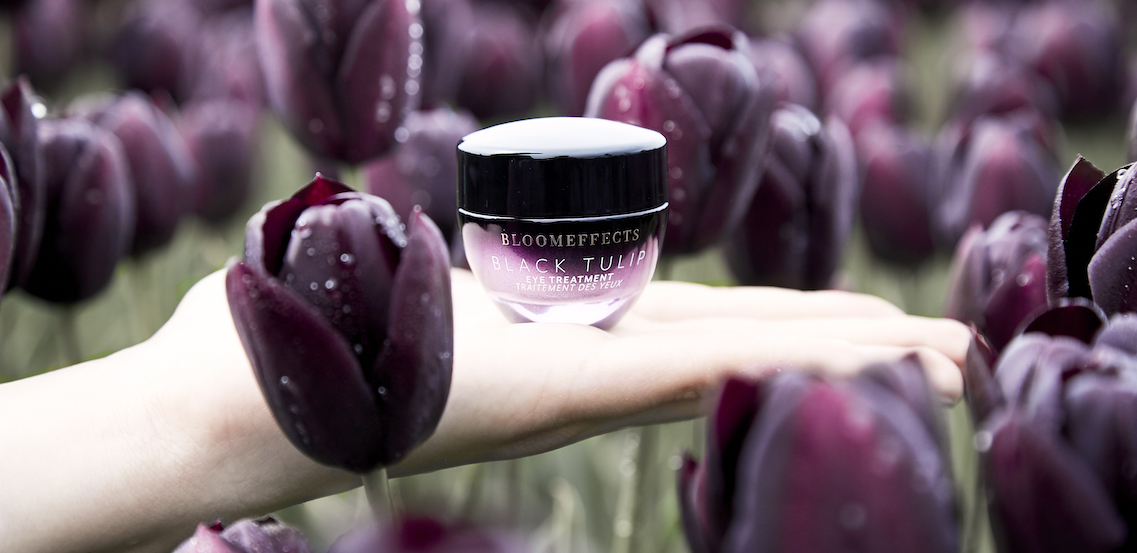Bloomeffects, the buzzy clean skin-care brand that derives its hero ingredient from tulips, is quickly accelerating its retail expansion plans.
On Friday, 2-year-old Bloomeffects launched a new trio of anti-aging products featuring black tulips on Bloomingdales.com and at six of the department store’s Wellchemist physical shops. The brand will expand to 15 doors at premium Mexican retailer Liverpool in November. The new collection includes an eye cream, a retinoid serum and a moisturizer. There’s also a cryotherapy facial tool for $80-$119, a more premium price point compared to the brand’s usual $29-$69 price range, for its products like a moisturizer, a cheek and lip tint, and a cleansing jelly for the face. Bloomeffects is already sold through Saks Fifth Avenue, QVC and Credo among others.
Bloomeffects’ sales are currently 35% via DTC e-commerce, and the plan is to bring that to 50% by end of 2022, said Kim van Haaster, Bloomeffects CEO and co-founder.
“Our focus in 2020 has been to have strong retailer relationships. Even with all the challenges of 2020, we have strengthened our base in the U.S.,” she said. “In 2022, from a product development standpoint, our focus is scientific research and sustainability and circular farming as it pertains to Dutch flowers. From a commercial perspective, [our focus is] global domination.”
Bloomeffects launched in Oct. 2019, first through Bluemercury before making its foray onto QVC in spring of 2020. After being forced to cancel its first QVC in-studio appearance in March 2020, Bloomeffects took part in four different takeovers across QVC’s social channels that spring, where the brand saw 500,000 social media impressions via likes, comments and shares. Its Earth Day 2020 Facebook Live segment, which coincided with its first TV segment, saw 232,000 views, which is 5.9x higher than historical averages, according to previous Glossy reporting.
“[Our experience with QVC] put us in a great position going into 2021 to have the backing and support of [more] retailers,” Hein van Haaster said. “In 2022 [we will focus on] expansion through Australia, Asia and Europe.”
A core narrative of Bloomeffects, including its black tulip collection, is its upcycling of varying tulip plant parts. Bloomeffects already uses non-commercially viable tulip bulbs for its existing assortment and decided to use tulip petals for the black tulip collection. According to Hein van Haaster, a fourth-generation tulip farmer (and Kim’s husband), over 2 billion tulips are “chopped” every year as an essential part of growing tulip bulbs. Upcycling has become the latest ingredient trend within the beauty industry, with skin-care brand brands like Farmacy, Circumference and Loli Beauty marketing it. Though Bloomeffects did not weigh the volume of the upcycled tulip petals, Hein van Haaster said the brand used approximately eight 700-meter rows of flowers, or about 1.2 million petals.
Ad position: web_incontent_pos1
To support the black tulip collection and explain its upcycling, Bloomeffects has produced 2-minute and 5-minute videos to share across its social channels which detail the science of the black tulip formulation, as well as the brand’s use of upcycled petals and the typical chopping process. Kim Van Haaster said that people who do not understand tulip farming practices can be critical, believing the flowers are being wasted. She added that, as a small indie brand, it does not have the “deep pockets” for significant advertising around the black tulip collection.
The videos and brand are meant to inspire an aspiration lifestyle and “a sense of hope and wanderlust.” And the collection is aimed at mature customers who want an elevated experience in their beauty routine. Outside of the video, Bloomeffects is conducting some Facebook and Instagram advertising for its Royal Tulip Nectar moisturizer.
Both Kim and Hein van Haaster said there is potential for Bloomeffects to expand its flower-based ingredients beyond tulips, as the family-owned farm also grows daffodils and hyacinths, among other flowers.
“There are so many flowers that haven’t even been researched yet to see what’s possible,” said Hein van Haaster. “[Dutch farming] is about working with nature instead of going against it.”


